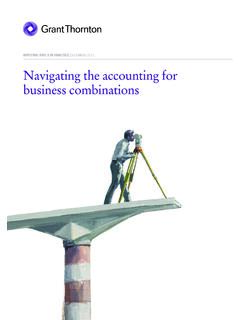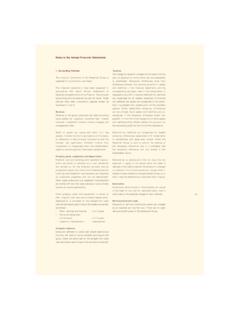Transcription of UNDERSTANDING DEFERRED TAX UNDER IAS 12 INCOME …
1 DEFERRED tax a Chief FinancialOfficer s guide to avoiding the pitfallsUNDERSTANDING DEFERRED TAX UNDER IAS 12 INCOME TAXES FEBRUARY 2013 Important Disclaimer:This document has been developed as an information resource. It is intended as a guide only and the application of its contents to specific situations will depend on the particularcircumstances involved. While every care has been taken in its presentation, personnel whouse this document to assist in evaluating compliance with International Financial ReportingStandards should have sufficient training and experience to do so. No person should actspecifically on the basis of the material contained herein without considering and takingprofessional advice. Neither Grant Thornton International Ltd, nor any of its personnel nor anyof its member firms or their partners or employees, accept any responsibility for any errors itmight contain, whether caused by negligence or otherwise, or any loss, howsoever caused,incurred by any person as a result of utilising or otherwise placing any reliance upon this tax iDeferred taxPreparation of financial statements underInternational Financial Reporting Standards(IFRSs) requires the application of IAS 12 IncomeTaxes (IAS 12).
2 INCOME taxes, as defined in IAS 12,include current tax and DEFERRED tax. For manyfinance executives the concepts underlying deferredtax are not intuitive. Applying these concepts alsorequires a thorough knowledge of the relevant taxlaws. IAS 12 takes a mechanistic approach to thecomputation but also requires significant judgementin some areas. For all these reasons, many ChiefFinancial Officers (CFOs) find that the calculationof a DEFERRED tax provision causes significantpractical difficulties. Fortunately, the member firms within GrantThornton International Ltd (Grant ThorntonInternational) one of the world s leadingorganisations of independently owned andmanaged accounting and consulting firms havegained extensive insights into the more problematicaspects of accounting for DEFERRED taxes UNDER IAS12. Grant Thornton International, through its IFRS team, develops general guidance that supports itsmember firms commitment to high quality,consistent application of IFRS.
3 We are pleased to share these insights bypublishing DEFERRED tax A Chief FinancialOfficer s guide to avoiding the pitfalls (the guide).The guide reflects the collective experience of GrantThornton International s IFRS team and memberfirm IFRS experts. It addresses IAS 12 s keyapplication issues related to DEFERRED taxes andincludes interpretational guidance in certainproblematic areas. Who should read this guideThis guide is intended for CFOs of businesses thatprepare financial statements UNDER IFRSs. Itillustrates IAS 12 s approach to the calculation ofdeferred tax balances but is not intended to explainevery aspect of the standard in detail. Rather, itsummarises the approach to calculating the deferredtax balance in order to help CFOs to prioritise andidentify key issues. The sections on avoiding thepitfalls will assist in UNDERSTANDING potentialproblem areas in order to know when to guide has been revised to reflect changesmade to IAS 12 up to 31 December Thornton International LtdFebruary 2013 IntroductionOverview of the guide1 Section 1: Calculating a DEFERRED tax balance the basics3 Section 2: Allocating the DEFERRED tax charge or credit12 Section 3: Disclosures17 Section 4: Avoiding pitfalls the manner of recovery and the blended rate22 Section 5: Avoiding pitfalls business combinations and consolidated accounts28 Section 6: Avoiding pitfalls share-based payments33 Section 7: Avoiding pitfalls recognition of DEFERRED tax assets36 Section 8: Avoiding pitfalls other issues40 Appendix A: Glossary47 ContentsDeferred tax.
4 Overview 1 Overview of the guide This guide summarises the approach to calculating a DEFERRED tax balance, allocating the DEFERRED tax chargeor credit to the various components of the financial statements, sets out disclosure requirements andprovides examples of the disclosures required by the standard. This guide also contains sections whichcover some of the more complex areas of preparation of a DEFERRED tax computation, for example thecalculation of DEFERRED tax balances arising from business combinations. The sections of the guide are asfollows:Section 1: Calculating a DEFERRED tax balance the basics IAS 12 requires a mechanistic approach to the calculation of DEFERRED tax. This section looks at thedefinitions in the standard and explains, through the use of a flowchart, how to navigate through therequirements of IAS 2: Allocating the DEFERRED tax charge or creditThe second section of this guide summarises the approach to allocating the DEFERRED tax charge or credit forthe year to the various components of the financial statements.
5 The DEFERRED tax charge or credit for theyear can arise from a number of sources and therefore may need to be allocated to: continuing operations within profit or loss discontinued operations within profit or loss other comprehensive INCOME or equity 3: Disclosures IAS 12 contains a number of disclosure requirements. In this section these disclosures are listed andexamples of how they can be presented are provided. These disclosures include: details of the components of the current and DEFERRED tax charge a reconciliation of the total tax charge to the profit multiplied by the applicable tax rate details of the temporary differences forming the DEFERRED tax asset or liability details of any unprovided DEFERRED tax nature of the evidence supporting the recognition of a DEFERRED tax 4: Avoiding pitfalls the manner of recovery and the blended rate Some assets or liabilities can have different tax effects depending on the manner in which they are expectedto be recovered or settled.
6 For example, the sale of an asset can give rise to a tax deduction, whereas the useof that asset might not give rise to a tax calculation of the DEFERRED tax balance should take into account the manner in which managementexpects to recover or settle an asset or liability. In many cases this may be obvious, in others it may not, andin others the manner of recovery will be a mix of both use and sale. This section looks at the practicalproblems associated with calculating the impact on the DEFERRED tax balance based on the expected mannerof recovery of an 5: Avoiding pitfalls business combinations and consolidated accountsBusiness combinations and consolidations give rise to complex DEFERRED tax accounting issues. This sectionconsiders a number of practical issues that can arise, specifically: whether DEFERRED tax should be recognised on intangible assets acquired in a business combination when DEFERRED tax arises on assets acquired in a business combination, whether the tax rate to beapplied is that of the acquiree or acquirer when DEFERRED tax is recognised in a business combination, whether this leads to an immediateimpairment of goodwill the provision of DEFERRED tax on unrealised intra-group profits eliminated on 6: Avoiding pitfalls share-based payments This section looks at two particular issues that arise in accounting for DEFERRED tax arising on share-basedpayments, specifically.
7 How to calculate the amount to be recognised in equity and the amount to be recognised in profit orloss how to account for DEFERRED tax on share based payments not caught by the measurement provisions of IFRS 2 Share-based Payment .Section 7: Avoiding pitfalls recognition of DEFERRED tax assets The recognition of DEFERRED tax assets is subject to specific requirements in IAS 12. DEFERRED tax assets arerecognised only to the extent that recovery is probable. This section covers: the recoverability of DEFERRED tax assets where taxable temporary differences are available the length of lookout periods for assessing the recoverability of DEFERRED tax assets the recognition of DEFERRED tax assets in interim financial 8: Avoiding pitfalls other issues This section is a summary of other issues which can arise in practice, namely: whether a particular taxation regime meets the definition of an INCOME tax the tracking of temporary differences arising on initial recognition the accounting for changes in an asset s tax base due to revaluation or indexation of that tax base the treatment of DEFERRED tax on gains and losses relating to an available-for-sale financial assetreclassified to profit or loss accounting for DEFERRED tax on compound financial instruments reflecting uncertainty over whether specific tax positions will be sustained UNDER challenge from therelevant tax authorities.
8 AppendixAppendix A to this guide provides a glossary of key terms used in IAS 12. 2 DEFERRED tax: OverviewDeferred tax: Section 1 3 Section 1: Calculating a DEFERRED tax balance the basicsSummary of approachIAS 12 requires a mechanistic approach to the calculation of DEFERRED tax. This section looks at thedefinitions in the standard and explains, through the use of a flowchart, how to navigate through therequirements of IAS following flowchart summarises the steps necessary in calculating a DEFERRED tax balance inaccordance with IAS 1 Establishing the accounting base of theasset or liabilityStep 2 Calculate the tax base of the asset orliabilityIf there is no difference between tax andaccounting base, no DEFERRED tax isrequired. Otherwise go to step 3 Identify and calculate any exempttemporary differencesStep 4 Identify the relevant tax rate and apply thisto calculate DEFERRED taxStep 5 Calculate the amount of any DEFERRED taxasset that can be recognisedStep 6 Determine whether to offset DEFERRED taxassets and What is the accounting base?
9 The accounting base of an asset or liability is simply thecarrying amount of that asset or liability in the statement offinancial position. In most cases, the determination of theaccounting base of an asset or liability is straightforward,however IAS 12 requires the calculation of DEFERRED tax to takeinto account the expected manner of recovery or settlement ofassets and some cases it might be necessary to consider splitting the carrying value of an asset between anamount to be recovered through use and an amount to be recovered through sale. Section 4 contains afurther discussion of assets whose carrying amount is recovered through use and What is a tax base?What is the tax base of an asset ?The tax base of an asset is defined as: ..the amount that will be deductible for tax purposes against any taxable economic benefits that will flow to an entity when it recovers the carrying amount of the asset . If those economic benefits will not be taxable, the tax base of the asset is equal to its carrying amount (IAS ).
10 What is the tax base of a liability?The tax base of a liability is defined as: ..its carrying amount, less any amount that will be deductible for tax purposes in respect of that liability in future periods. In the case of revenue which is received in advance, the tax base of the resulting liability is its carrying amount, less any amount of the revenue that will not be taxable in future periods (IAS ).Example 1 the tax base of an assetCompany A purchased an item of property, plant and equipment for CU10,000. Over the life of the asset , deductions of CU10,000 will be available in calculating taxable profit through capital allowances. All deductions will be available against trading INCOME and no deductions will be available on sale. Management intends to use the deductions of CU10,000 will be available over the life of the asset , the tax base of that asset is CU10, base of a revalued asset that is not depreciatedWhen an asset is revalued UNDER IAS 16 Property, Plant and Equipment and that asset is non-depreciable,the carrying amount of that asset will not be recovered through use.











